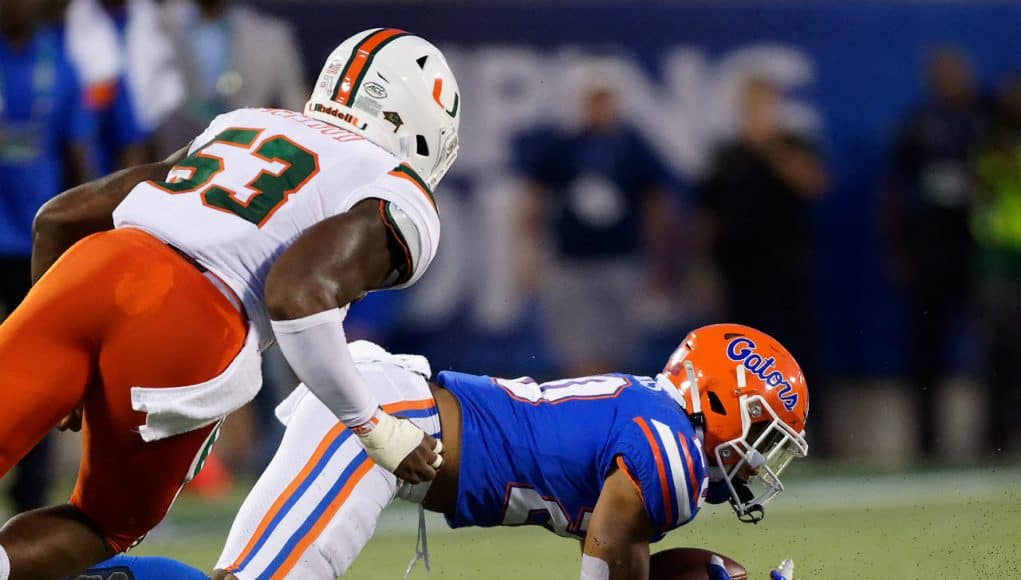Midway through the second quarter the Florida Gators offense was doing it’s best job or trying to tire out Miami’s offense by keeping them on the field.
Feleipe Franks and Lamical Perine botched a handoff that resulted in a turnover. Florida’s defense did its job, forcing a 3-and-out. Two plays later Feleipe Franks took a shotgun snap before pitching the ball to Davis on the near side of the field. The ball hit Davis’ hands but it appeared the running back started to run before he secured the ball and it hit the turf. It was a lateral, so the ball is live. Davis fell on it and secured possession of the football.
His elbows were down on the turf. His knees were down on the turf.
Davis did attempt to get back up after he fell on the fumbled ball and he was clocked, fumbling it again. Center Nick Buchanan fell on the ball but after a scrum Miami linebacker Shaquille Quarterman came up with it and Miami was awarded the ball, bringing the turnover chain back out on the sideline. Miami turned the fumble into three points to make the score 7-6.
The NCAA rulebook is long and dry — not the book you’d bring to the beach to enjoy on a Saturday afternoon — so allow me to jump to the pertinent parts of it and save you the time.
Section 11. Article 1.
To fumble the ball is to lose player possession by any act other than passing, kicking or successful handing (A.R. 2-19-2-I and A.R. 4-1-3-I). The status of the ball is a fumble.
Rule 4. Section 1. Article 3. “The ball becomes dead when…”
b. When any part of the ball carrier’s body, except his hand or foot, touches the ground or when the ball carrier is tackled or otherwise falls and loses possession of the ball as he contacts the ground with any part of his body, except his hand or foot [Exception: The ball remains alive when an offensive player has simulated a kick or at the snap is in position to kick the ball held for a place kick by a teammate. The ball may be kicked, passed or advanced by rule] (A.R. 4-1-3-I).
In college the referees initiate most replays. Every game has a head replay official and play can be stopped at any point of the game. Additionally, head coaches are allowed to challenge plays, once a game. The coach has to call a timeout — Florida had all three timeouts available to them at the time. If the challenge is successful he gets the timeout back.
The turnover was the second in as many drives for the Gators and gave Miami very good field position. There was an opportunity for Mullen to challenge the play. On the television broadcast there was approximately 1 minute and 17 seconds between the called turnover on the field and when Miami snapped the ball.
Mullen elected not to call a timeout and challenge the call.
“I really did think about it. To be honest with you, I thought he had the ball; he was on a knee and he went to stand up and made a football motion and the ball came out,” Mullen said when asked about the decision after the game. “Someone called maybe it could have even been a late hit on that, our ball and plus 15 yards when someone calls that way. But I just — I don’t think that’s one that, in such a bang-bang play, that you’re going to win. You guys probably have better looks at it, but I’m guessing that would have been a call stands type of deal. Maybe not.”
What the referees would have been making a judgment on is if Davis had clear possession of the ball, that it wasn’t juggling around in his arms while his knees and elbows were down on the ground. To be down and for a ball to be dead a player must have possession. In real time, even watching it back, that’s unclear. Another argument would be that with 10 minutes to go before halftime and three timeouts you can afford to burn a timeout in an attempt to get a blown call overturned.
Mullen will turn that play in to league officials for a review, something that happens each week to gain clarification or get explanations for things that happened in a game.



Terrible decision by Mullen not to challenge that call. Not only did it look like Davis was down, but two Gators eventually ended up on top of the ball at the end of the play. That’s not worth a timeout to challenge when the momentum has totally turned in Miami’s favor?